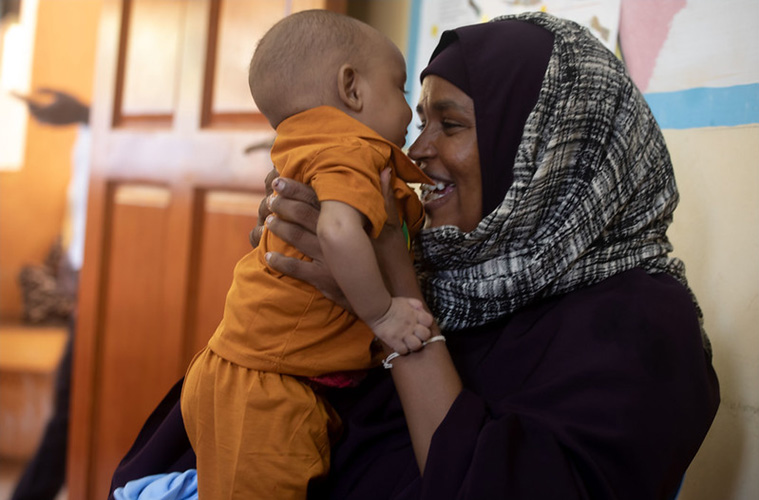 A mother and her child at a Public Health Centre of one of the drought-affected districts in Kismayo, Somalia. Photo credit: WHO Somalia/I. Taxta1 May 2024, Mogadishu, Somalia – A 12-month project led by the WHO Country Office in Somalia over the course of 2023 reached 3 137 217 people affected by drought or flood. The project was made possible thanks to the generous support of the Government of Japan.
A mother and her child at a Public Health Centre of one of the drought-affected districts in Kismayo, Somalia. Photo credit: WHO Somalia/I. Taxta1 May 2024, Mogadishu, Somalia – A 12-month project led by the WHO Country Office in Somalia over the course of 2023 reached 3 137 217 people affected by drought or flood. The project was made possible thanks to the generous support of the Government of Japan.
Initially intended to address drought, Japan’s support swiftly adapted to the evolving situation in Somalia. Starting in October 2023, the country was hit by El Niño-related heavy rainfall. This resulted in severe flooding that affected more than 2.4 million people and led to the destruction of 31 health facilities. The surge in demand for emergency health services prompted the reallocation of Japan’s available funds to also facilitate WHO’s flood response.
With the critical support of donors, including Japan, humanitarian and development actors worked with the Government of Somalia on the drought response. This successfully prevented a nationwide famine arising from the 2022–2023 drought crisis. There is still much work to be done, however, as the same communities continue to be affected by the impacts of other extreme climate events.
“The support from Japan played an important role in enabling WHO to reach millions of vulnerable individuals in Somalia who were affected by extreme climate events,” said Dr Ifeanyi Okudo, Incident Manager at WHO Somalia. “We are pleased to deliver the project objective of averting preventable loss of life by strengthening the outbreak detection and implementing an integrated health and nutrition package for the most affected.”
With over US$ 700 000 in financial support received from Japan, WHO was able to deploy 369 community health workers and 121 mobile outreach teams in drought-affected areas. These provided essential health and immunization services to local population with a special focus on children and pregnant and lactating women.
Through this project, basic health and nutrition services were delivered to more than 1.5 million people, including nearly 480 000 children aged under 5 years and more than 250 000 women of childbearing age. Through routine immunization efforts, close to 410 000 children received the pentavalent 3 and measles-containing vaccines.
This surge capacity to provide essential services effectively complemented the routine activities of the local health system, mitigating severe service disruption caused by climate events and consequent mass population displacement. The project also supported health facilities: for example, 369 primary health care units were provided with essential medicines and supplies, benefiting over 3 million people who receive their health services in these health facilities.
Japan’s funding also enabled WHO Somalia to support the treatment of children with severe acute malnutrition, by providing 29 stabilization centres with supplies and supervision support. A stabilization centre is a fixed health care unit where children with severe acute malnutrition with medical complications are referred, admitted, and treated. These WHO-supported stabilization centres maintain a cure rate of above 90%.
“The support from Japan and WHO has been vital in responding to drought and floods, and providing treatment to children suffering from severe acute malnutrition with medical complications [SAM/MC] at our stabilization centres,” said Mr Farhan Mohamed, Head of Nutrition, Federal Ministry of Health.
“Thanks to the comprehensive training sessions provided to health care providers, we have been able to enhance the capacity of our health care workers and provide high-quality services, resulting in a high cure rate for SAM/MC,” he added. “In addition, the funding made it possible for us to deploy critical resources and personnel to the most severely affected areas, where they had a significant impact on saving lives and averting famine.”
Finally, the project allowed WHO to help the Federal Ministry of Health enhance its epidemic surveillance and response mechanism through community-based surveillance. Now, community health workers send alerts based on danger signs they see in the communities they serve, and rapid response teams verify the alerts. As a result, 84.2% of all outbreak alerts raised in 2023 were addressed within 48 hours, and 92.1% of all cases were confirmed. WHO has also been assisting the Federal Ministry of Health to produce weekly epidemiological situation reports.
For more information, contact:
Madinur Saydahmat, Partnerships Officer, WHO Somalia
Email:
This e-mail address is being protected from spambots. You need JavaScript enabled to view it
Fouzia Bano, Communications Officer, WHO Somalia
Email:
This e-mail address is being protected from spambots. You need JavaScript enabled to view it




